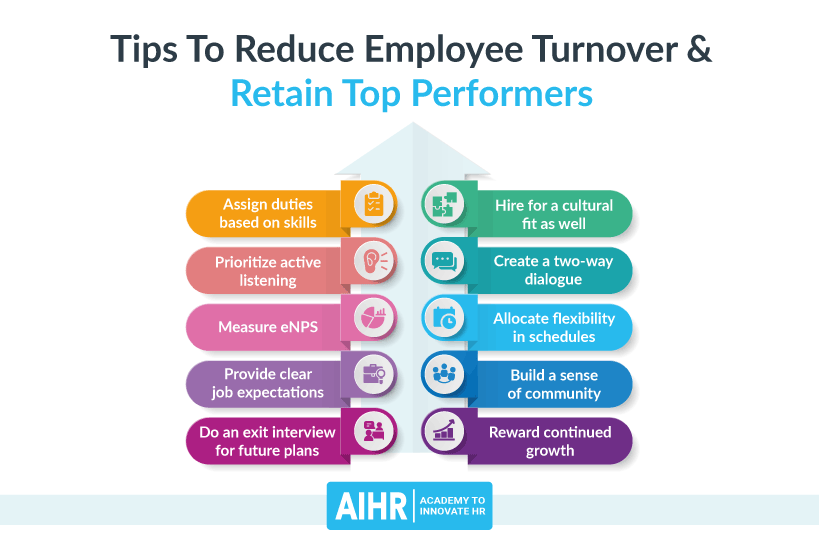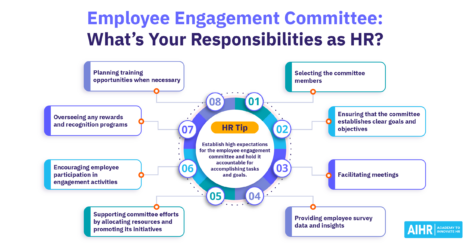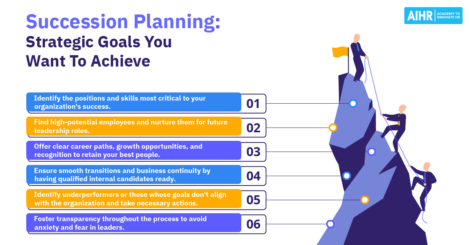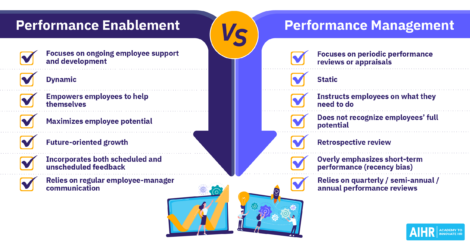10 Tips To Reduce Employee Turnover & Retain Top Performers

What is one tip you have to help reduce employee turnover?
To help business leaders reduce employee turnover and, in turn, increase the employee retention rate, we asked HR professionals and business leaders this question for their best tips. From rewarding continued growth to providing clear job expectations, there are several strategies to help you decrease turnover and grow your business for years to come.
Here are ten tips to reduce employee turnover and retain top performers!
Contents
Assign duties based on skills
Prioritize active listening
Measure eNPS
Provide clear job expectations
Do an exit interview for future plans
Hire for a cultural fit as well
Create a two-way dialogue
Allocate some flexibility in schedules
Build a sense of community
Reward continued growth
Assign duties based on skills
With over ten years of experience as a business owner of an independent insurance agency, I’ve learned a few things when it comes to reducing employee turnover. My best tip is to learn how to delegate tasks well within your company. This is easier when you know your company really well.
But don’t delegate at free will. Make sure you’re doing it as evenly as possible amongst the team. Assign tasks to people who have the tools and skills to complete them. If you can give people tasks that they have the means to carry out and not stockpile, employees tend to be happier and more productive.

Brandon K. Berglund, Berglund Insurance
Prioritize active listening
I have found that actively listening to people and responding to them in a timely manner helps people feel heard and cared for in their workplace. This, in turn, can help retain the best of the best. I check my emails at the same time every day and allow myself a certain amount of time to get through everything. If I open and read an email, I try to respond to it then. This way, there’s no wasted time, and the person waiting for a response doesn’t feel like they’re being ignored. This simple practice has proven to be very effective; not only for me but also for the person on the other end who requires a response by reducing lag time and keeps morale high in the office.

Ryan Nouis, TruPath
Measure eNPS
Measuring eNPS (Employee Net Promoter Score) helps our company keep a pulse on employee satisfaction across important categories like Work-Life Balance, Relationships With Peers, and Mental Health. By issuing employee surveys that they can answer anonymously, we are able to proactively address areas that we may be falling short. It also enables us to learn from areas where we may be finding success. Whether it’s ENPS or another employee satisfaction metric, quantitatively measuring employee happiness can help address employee turnover.

Brett Farmiloe, Markitors
Providing clear job expectations
Be upfront with candidates about what exactly the position they’re applying for entails. Don’t say things that aren’t true, and don’t avoid discussing various circumstances they may encounter. For instance, be clear about how many hours they will be working and if they may need to work weekends sometimes. If you’re not transparent with your employees from the start, they may end up resenting this misrepresentation of their jobs and opt to move on.

Mary Berry, Cosmos Vita
Do an exit interview for future plans
It’s so important to truly understand why employees are leaving your company in order to ultimately reduce employee turnover. Exit interviews are a great way to have a candid conversation about the workplace. It allows you to learn any areas of the position or company as a whole that could use improvements to ensure future employees stay happier longer. The more information you can gather from leaving employees, the more changes you can make to improve the likelihood of longer-lasting employees. That way, you eventually reduce employee turnover rates.

Patrick Hicks, Trust & Will
Hire for a cultural fit as well
Companies should strive to hire employees that are a natural fit culturally. Hiring employees that fit well within the company’s culture will lead to more positive outcomes for both the company and the employee. Employees who are culturally aligned with the company enjoy greater job satisfaction. They also demonstrate greater intrinsic motivation to do their job right. Such employees are more committed to the company, meaning they are less likely to quit or be fired.

Carol Tompkins, AccountsPortal
Create a two-way dialogue
Listen to your employees. Ask them what it is they’re looking to get out of their employment. What can make for a better experience? By creating a two-way dialogue, offering the right incentives, and encouraging feedback, you can improve overall efficiency and make for a more profitable and better environment. Praising your employees and encouraging them when they need help inevitably creates an environment where they feel a part of a team dynamic. They are more willing to reciprocate the sentiment. Employees want to feel engaged and a part of your company’s success. Finding the correct role based on each employee’s strength is crucial to creating a thriving team environment and keeping them on board.
Katie Lyon, Allegiance Flag Supply
Allocate some flexibility in schedule
Our company is in an online marketplace that’s open 24-hours a day, 7 days a week. Whether it’s updating our site with new product offerings, ensuring our tech is running smoothly, or interacting with customers to answer questions they may have, we need employees around the clock. So, to keep turnover low, we embrace a flexible schedule. Offering flexible hours opens our talent field to include students who want to work while pursuing their education goals, parents who want a better work-life balance, and the more senior workforce who aren’t ready to retire. By sharing control over their schedules, we find our workers are happier and more motivated. Their productivity level is high, and the burnout rate is low. As a result, we have retained more employees longer and have built a more qualified team.

Shahzil Amin, WellBefore
Build a sense of community
Build genuine relationships with the folks you work with. If you are someone in a higher position, make sure you know what the people under you are doing. Reach out to them and ask about their families, their lives outside of work. The more people can feel like they’re connected to those they work with, the better work they’ll do. And you’ll have less turnover.

Zoe Waters, Necessary Behavior
Reward continued growth
We offer our employees both a growth plan where we outline their career goals + a yearly stipend for training or resources to help them achieve them. While this doesn’t guarantee an employee will remain with us, more often than not, we try to help them plan for goals or career steps that might be available with our organization now or in the future. Our goal is to not only help our staff grow professionally but also to help them grow into roles they are interested in internally with realistic timelines.

Quincy Smith, TEFL Hero
These expert insights have been collected by Terkel. Terkel creates community-driven content featuring expert insights.
Weekly update
Stay up-to-date with the latest news, trends, and resources in HR
Learn more
Related articles
Are you ready for the future of HR?
Learn modern and relevant HR skills, online













